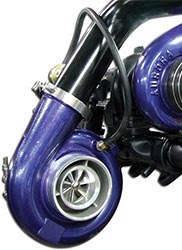I have been around turbos for a long time. So this page is also to help me keep information in one place, so I don't need to look all over the web everytime I need some information about a turbocharger.
I'm very technical in person, I enjoy taking stuff apart and look how it's made. And the same goes for turbos. I took apart a Holset turbo that I have a few months ago. And was pleasantly supprised. The Holset turbo had a Billet Compressor wheel, maram shaft (exellent for anti lag) and floating journal bearings.
The turbo is a Holset HX52 turbocharger. It's a 67mm turbo (Inducer) Twinentry T4 flange with a 16cm exhaust housing. And 70mm Exducer. The power you can get from this turbo is around 700 whp.
That's on a 4x4 car with E85 in the tank. You can't get 700 whp with the 16cm housing that easy because it's a little bit to small.
So if you are planing on breaking 700 whp you should look for a bigger exhaust housing. I know only one car (as of today Feb 2011) a front wheel drive Honda that have broken 700 whp with a 16cm housing. And that was on high octance race gas. So i'm not saying it can't be done, just that it's less problematic if you put on a bigger exhaust housing.
Some people say that because the Holsets are made for diesels they don't work on "normal" cars running on pump gas. And won't spool good. Well that's not true. However the Holset turbos are picky when it comes to how you build you're manifold.
Holset turbos are pulse driven turbos. Because diesels have colder exhaust gases the turbos need to be more efficient with the energy given to them than other turbos. So they will work best and spool up best if you run pulesplit manifolds.

Above picture is of the same Holset HX52 turbo Vs the smaller Holset HX35. The HX35 is a 54mm turbo (Inducer) Twinentry T3 flange. Running a 12cm exhaust housing. And 60mm exducer. The small HX35 is a solid 500 whp turbo. Many people are running these, and are very happy with them.
You may wonder what anti lag is that i mentioned above and what it means. And it's the bangs you hear from the rally cars. It keeps the turbocharger spinning and delivering boost pressure to the engine all the time even when the throttle is closed.
How do I know? I live in Finland. There's a saying when it comes to auto racing "If you want to win, employ a finn!" There is rumours that there's rally cars hidden away in every bar here in Finland. And that's the reason we are so good at what we do. Well I would not say every barn, but I know of a few... No but we do start racing at an early age. And the weather conditions here, snow in winter together with twisty roads helps train people.
This page however I will try to keep to turbochargers and have a good amount of information about them.
I'm trying to keep a very good collection and with all the information, so things like. Inducer, Exducer, Exhaust housing, Compressor wheel, Turbine wheel, Twinentry, Single entry, power that can be extracted and so on will be included.
I made the decision that I will not include older turbos here. I will have some information on them, but I will not spend to much time on turbos like the old Garrett T3 from Garrett's T-Series and the like from "the eighties". It's 2011 now and turbocharger technology have gotten way better now and I recommend that if anyone is still using an old turbo like that. Change it fast. You won't regret it.
To give you an example an ordinary Holset HX40 (this is a 600 whp turbo) with a good manifold will spool up like an Garrett T3 turbo. So that should be reason enough for you to get rid of that old turbo of yours.
Also a good little investment is a thing called a Flow Control Valve from Tilton. Supposedly reduces the chances of you destroying your gearbox or other transmission parts.
The description says_:
Tilton flow control valve is designed to reduce shock loads to the driveline
by allowing the clutch to slip slightly during engagement. Shock load is a
result of an abrupt clutch engagement when the crankshaft and input shaft
speeds are not precisely matched. The flow control valve is designed to
reduce the chance of losing traction when downshifting and/or the chance
of damaging driveline components.
Fluid flow is not restricted during clutch disengagement. Therefore, shift
times are still quick and pedal feel is not altered. The valve will have an effect
on quick clutch actuations only. It will not alter fine clutch modulation.
Includes three orifice sizes (.021", .028", .040") that enable clutch
engagement to be tuned. The valves features AN3 fittings for use with most
Tilton master cylinders and –3 hydraulic lines.
Description
Part Number Flow control valve 90-5000
I'm very technical in person, I enjoy taking stuff apart and look how it's made. And the same goes for turbos. I took apart a Holset turbo that I have a few months ago. And was pleasantly supprised. The Holset turbo had a Billet Compressor wheel, maram shaft (exellent for anti lag) and floating journal bearings.
The turbo is a Holset HX52 turbocharger. It's a 67mm turbo (Inducer) Twinentry T4 flange with a 16cm exhaust housing. And 70mm Exducer. The power you can get from this turbo is around 700 whp.
That's on a 4x4 car with E85 in the tank. You can't get 700 whp with the 16cm housing that easy because it's a little bit to small.
So if you are planing on breaking 700 whp you should look for a bigger exhaust housing. I know only one car (as of today Feb 2011) a front wheel drive Honda that have broken 700 whp with a 16cm housing. And that was on high octance race gas. So i'm not saying it can't be done, just that it's less problematic if you put on a bigger exhaust housing.
Some people say that because the Holsets are made for diesels they don't work on "normal" cars running on pump gas. And won't spool good. Well that's not true. However the Holset turbos are picky when it comes to how you build you're manifold.
Holset turbos are pulse driven turbos. Because diesels have colder exhaust gases the turbos need to be more efficient with the energy given to them than other turbos. So they will work best and spool up best if you run pulesplit manifolds.

Above picture is of the same Holset HX52 turbo Vs the smaller Holset HX35. The HX35 is a 54mm turbo (Inducer) Twinentry T3 flange. Running a 12cm exhaust housing. And 60mm exducer. The small HX35 is a solid 500 whp turbo. Many people are running these, and are very happy with them.
You may wonder what anti lag is that i mentioned above and what it means. And it's the bangs you hear from the rally cars. It keeps the turbocharger spinning and delivering boost pressure to the engine all the time even when the throttle is closed.
How do I know? I live in Finland. There's a saying when it comes to auto racing "If you want to win, employ a finn!" There is rumours that there's rally cars hidden away in every bar here in Finland. And that's the reason we are so good at what we do. Well I would not say every barn, but I know of a few... No but we do start racing at an early age. And the weather conditions here, snow in winter together with twisty roads helps train people.
This page however I will try to keep to turbochargers and have a good amount of information about them.
I'm trying to keep a very good collection and with all the information, so things like. Inducer, Exducer, Exhaust housing, Compressor wheel, Turbine wheel, Twinentry, Single entry, power that can be extracted and so on will be included.
I made the decision that I will not include older turbos here. I will have some information on them, but I will not spend to much time on turbos like the old Garrett T3 from Garrett's T-Series and the like from "the eighties". It's 2011 now and turbocharger technology have gotten way better now and I recommend that if anyone is still using an old turbo like that. Change it fast. You won't regret it.
To give you an example an ordinary Holset HX40 (this is a 600 whp turbo) with a good manifold will spool up like an Garrett T3 turbo. So that should be reason enough for you to get rid of that old turbo of yours.
Also a good little investment is a thing called a Flow Control Valve from Tilton. Supposedly reduces the chances of you destroying your gearbox or other transmission parts.
The description says_:
by allowing the clutch to slip slightly during engagement. Shock load is a
result of an abrupt clutch engagement when the crankshaft and input shaft
speeds are not precisely matched. The flow control valve is designed to
reduce the chance of losing traction when downshifting and/or the chance
of damaging driveline components.
Fluid flow is not restricted during clutch disengagement. Therefore, shift
times are still quick and pedal feel is not altered. The valve will have an effect
on quick clutch actuations only. It will not alter fine clutch modulation.
Includes three orifice sizes (.021", .028", .040") that enable clutch
engagement to be tuned. The valves features AN3 fittings for use with most
Tilton master cylinders and –3 hydraulic lines.
Description
Part Number Flow control valve 90-5000
I also have more technical pages for you that will come in handy. They will be of great help when looking at compressor maps Use the conversion tools And you will be able to calculate airflow, pressure and HP figures for the turbocharger you are interested in.


































4 comments:
Where I can find the hx52 housing 16cm2?
Hi
You can get new spares from any local Holset distributor. Or you can get used ones on Ebay if you know what you are looking for. The HX52 turbocharger part number is 3599996. And the 16cm2 exhaust housing part number is 3598949 or 3598950. Exhaust housing air ratio (A/R) is 16cm and these comes with the V-band clamp.
Hey man if u could pls provide specs for gt 17 that would much appreciated
Cheers
Hello, the GT17 turbos come in a few different shapes and sizes but for the most part they are most efficient around 1 bar / 15 psi boost and support around 200 lb/min air flow. That should give you around 190hp with a good tune.
Post a Comment